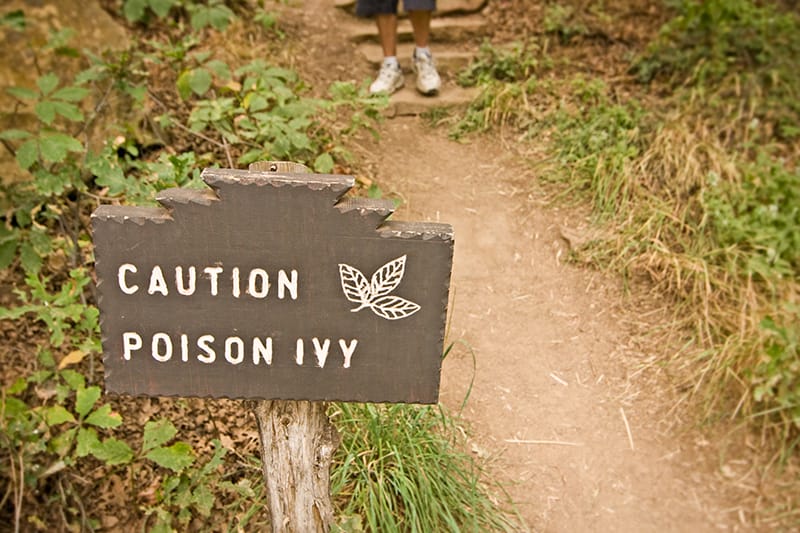Allergy sufferers are well aware of the downsides of the lush, green landscape waiting outside when the Iowa weather finally warms up. A sunny day spent outside can leave them with the aftermath of seasonal allergies.
There are other plant allergens that aren't found in the pollen count that can cause allergic reactions. Eighty-five percent of Americans are allergic to one particular plant poison — urushiol, the oily sap found in poison ivy, poison oak and poison sumac. And many are unaware that they were ever around these plants until it's too late.
Poison ivy, oak and sumac leave a mark.
Touch one of these plants, and there's a good chance you'll get a rash. The plants' oils cause allergic contact dermatitis, a type of eczema that occurs when an allergen gets on your skin. The resulting rash makes your skin:
- Red and swollen – The rash is often streaked or has a linear pattern that follows the shape of the plant. Depending on how much of your skin was exposed, it could cover a small area or be widespread all over your body.
- Itchy – The reaction makes you want to scratch, which can worsen the rash and help it spread across your skin.
- Blister – Your skin forms bumps that can turn into blisters that break and ooze, especially if you're scratching.
Urushiol penetrates your skin in as little as five minutes after you touch it, but your allergic reaction doesn't happen right away. The rash can show up anywhere between four hours to two days later and last for two to three weeks.
You don't have to touch the leaves of poison ivy, poison oak or poison sumac to get a rash. You don't even have to touch the plant! The sap courses through the vine's veins. It's in the stems, vines, roots and berries. If the plant has been disturbed, the sap is released, clinging to anything it touches.
Urushiol could be in your dog's fur, on your shoes, or on the handle of a rake or gardening tool. And it can remain an active irritant for months. Long after the initial exposure and after your rash has gone away, you can get red and itchy all over again by touching something that still has the sap on it.
Only poison ivy is found in Iowa.
It's a common misperception. But poison oak and poison sumac have never been documented by botanists as growing in the state of Iowa, according to the Iowa Department of Natural Resources. There are plants, even oak and sumac species, that look similar but are not poisonous. Some people mistakenly think that a different-looking species of poison ivy is actually poison oak or poison sumac.
Poison ivy, however, is prevalent in the state. It can be seen creeping along a hiking path or up the trunk of a tree in your own backyard. It's everywhere! Poison ivy is the most common cause of contact dermatitis in the United States.
If you leave the state on a summer vacation, you may also run into its cousins. Poison sumac is primarily found in the eastern part of the country, as well as Minnesota, Wisconsin and Illinois. Poison oak is native to the West Coast and the Southeast. If you'll be spending a lot of time outdoors in these areas, the Centers for Disease Control and Prevention mapped out the geographic distribution of poisonous plants so you know what to avoid.
You can treat a poison ivy rash at home.
Most cases of poison ivy rash aren't serious. You can treat the rash and relieve the itch with home remedies.
For milder rashes and symptoms, try these at-home poison ivy treatments:
1. Wash away the oily sap, ASAP.
"Step one is to avoid poison ivy as much as possible. If you do come in contact with it, it's important to wash the oils off right away," says William Schupp, MD, Family Medicine physician at The Iowa Clinic on Alice's Road in Waukee.
Rinse your skin immediately! Whether you know you touched poison ivy or didn't know until you saw a rash, rinse the exposed areas to wash away the oils and prevent the poison ivy rash from spreading to other areas of your body.
Don't stop there. Wash everything else that may have come in contact with the poison ivy oil — clothes, pets, tools, door handles and any other hard surfaces. Warm, soapy water is all you need.
2. Take a bath — in oatmeal.
Short baths or showers can help ease the symptoms. Cold showers can help but lukewarm baths are better. Try adding a cup of baking soda to the running water or using a colloidal oatmeal mixture.
The oatmeal binds to your skin and creates a protective barrier from irritants. It's commonly used in skincare products, and you can find preparations at your nearest pharmacy. You can also prepare your own colloidal oatmeal mixture with regular oatmeal or whole oats. Grind them into a fine powder with a coffee grinder, blender or food processor until they can create a white, milky liquid when added to water.
3. Soothe your skin and your urge to scratch.
"Keep the itch down with hydrocortisone cream and calamine lotion," advises Dr. Schupp. Any creams or lotions with antihistamines should be avoided. They can actually make the itch and rash worse. The same goes for scratching or removing the skin from blisters. Fight the urge! Both just open your skin up for infections.
4. Pop an antihistamine pill.
While the creams should be avoided, oral antihistamine pills like Claritin or Benadryl are okay. They provide temporary relief by blocking the histamines your body releases in response to the allergen.
"If these aren't controlling your symptoms or the coverage is too widespread for topical medications, then it's time to see the doctor," Dr. Schupp says.
Severe reactions or blistering and widespread rashes are more serious. Especially if they lead to a lot of swelling, fever, difficulty breathing or trouble swallowing. A poison ivy rash on your face, near your eyes or in other sensitive areas is also cause for concern. If you have the symptoms of a severe poison ivy rash, head to urgent care or the emergency room for treatment.
Leaves of three, let it be.
It's a catchy saying — and one all Iowans should know. Poison ivy leaves grow in threes on a vine or stemming from a small plant or shrub. However, it's not the only plant that fits that description. Poison oak and other species grow that way as well.
To identify poison ivy, look at the leaves more closely. They can be shiny with sap or dull and are between two and five inches. They're typically red in the spring, green in the summer and yellow or orange in the fall.
Even if you're not 100 percent sure if a plant is poison ivy, steer clear! That's the best way to prevent allergic contact dermatitis and keep the itchy, red rash that comes with it.


